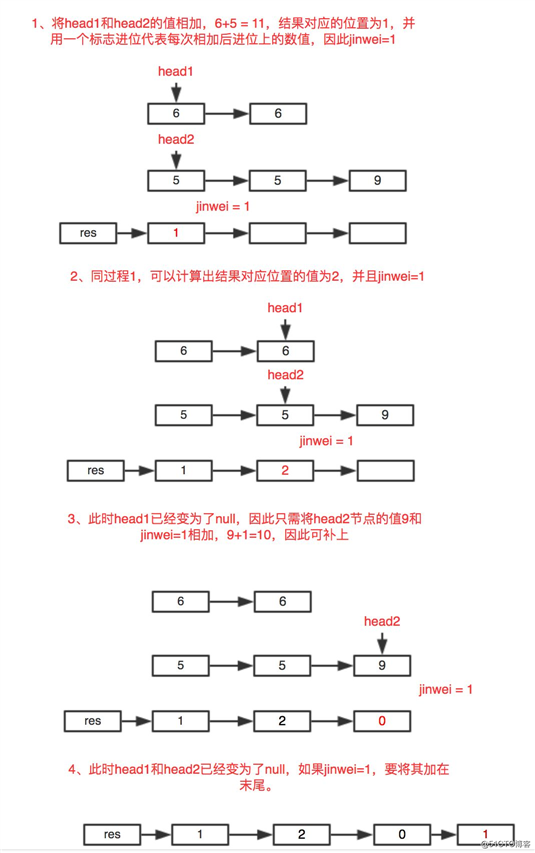标签:表示 next 存储 运算 amp 怎么 好的 技术 不为
leetcode2. 两数相加--每天刷一道leetcode系列!
作者:reed,一个热爱技术的斜杠青年,程序员面试联合创始人
给出两个 非空 的链表用来表示两个非负的整数。其中,它们各自的位数是按照 逆序 的方式存储的,并且它们的每个节点只能存储 一位 数字。
如果,我们将这两个数相加起来,则会返回一个新的链表来表示它们的和。
您可以假设除了数字 0 之外,这两个数都不会以 0 开头。
示例:
输入:(2 -> 4 -> 3) + (5 -> 6 -> 4)
输出:7 -> 0 -> 8
原因:342 + 465 = 807运算规则和我们怎么做加法很像。我们做加法的时候加数和被加数的个位相加产生和的个位数,并且如果相加的结果大于10,需要向十位产生进位。同理十位、百位。
此题中我们也可以采取这种方式。
(head1.val + head2.val + jinwei) % 10 就是结果中此位置的值。而新的进位为(head1.val + head2.val + jinwei) / 10 。
有两个地方是主要注意的。
1、可能会出现head1或者head2已经为null了的情况。
2、最后head1和head2均为null以后,还要考虑jinwei如果不为0的情况,此时要加其加至链表末尾。
通过下图能很好的解释分析中介绍的内容。

public ListNode addTwoNumbers(ListNode l1, ListNode l2) {
if (l1 == null) {
return l2;
}
if (l2 == null) {
return l1;
}
int jinwei = 0;
ListNode res = new ListNode(-1);
ListNode tmp = res;
while (l1 != null && l2 != null) {
int sum = l1.val + l2.val + jinwei;
res.next = new ListNode(sum % 10);
res = res.next;
jinwei = sum / 10;
l1 = l1.next;
l2 = l2.next;
}
while (l1 != null) {
int sum = l1.val + jinwei;
res.next = new ListNode((sum) % 10);
res = res.next;
jinwei = sum / 10;
l1 = l1.next;
}
while (l2 != null) {
int sum = l2.val + jinwei;
res.next = new ListNode((sum) % 10);
res = res.next;
jinwei = sum / 10;
l2 = l2.next;
}
if (jinwei == 1) {
res.next = new ListNode(1);
}
return tmp.next;
}下面这种代码看起来或许会更简洁一点。
public ListNode addTwoNumbers2(ListNode l1, ListNode l2) {
if (l1 == null) {
return l2;
}
if (l2 == null) {
return l1;
}
int jinwei = 0;
ListNode res = new ListNode(-1);
ListNode tmp = res;
while (l1 != null || l2 != null) {
int val1 = l1 == null ? 0 : l1.val;
int val2 = l2 == null ? 0 : l2.val;
int sum = val1 + val2 + jinwei;
res.next = new ListNode(sum % 10);
res = res.next;
jinwei = sum / 10;
if (l1 != null) {
l1 = l1.next;
}
if (l2 != null) {
l2 = l2.next;
}
}
if (jinwei == 1) {
res.next = new ListNode(1);
}
return tmp.next;
}写在最后:单个人的力量是有限的,如果你有更好的解法,欢迎留言交流。
leetcode2. 两数相加--每天刷一道leetcode系列!
标签:表示 next 存储 运算 amp 怎么 好的 技术 不为
原文地址:https://blog.51cto.com/15047485/2559863